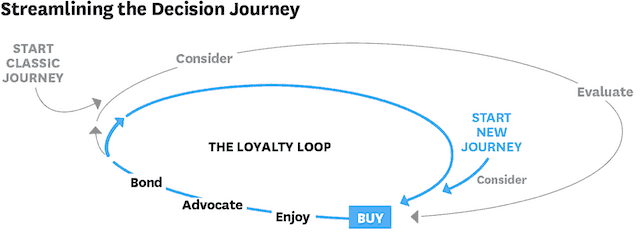Are you looking for ways to increase sales, boost product exposure, and maximize ROI on your marketing investments?
The options to promote your products online have increased considerably.
Find out how retailers are leveraging their catalogs to sell more products on shopping channels and marketplaces, taking advantage of Product Feed Marketing.
Buy Now!

Here’s what’s new In Product Feed Marketing
- Instagram Product Feeds for Shoppable Posts
- Enhanced price comparison shopping on Google and Bing
- Snapchat Product Feeds for Product Ads, Story Ads, Snap Ads, and Collection Ads
- Using keywords to sell using Amazon Product Ads
The Customer Journey has Changed
As mentioned in Competing on Customer Journeys, the classic customer journey map has evolved into a shortened process where buyers are quicker to consider and evaluate brands.
Smart eCommerce retailers understand that to capitalize on the new customer journey, their products need to be in front of their customers at the right time, and the right place.
“Instead of reacting to the journeys that consumers themselves devise, these companies are shaping their paths.” — David C. Edelman and Marc Singer

What is Product Feed Marketing?
Product feed marketing is a method in which a product data feed is used to distribute and sync product information from a retailer’s website to multiple online marketing and distribution platforms.
Product Feed Marketing Process
Online distribution channels used in product feed marketing include:
– Search engines
– Online marketplaces
– Comparison shopping sites
– Retargeting services
– Affiliate marketing partners
– Social media commerce
Examples of Online Distribution Channels
Each channel requires its data feed to be formatted differently. Here are some examples of product data feed requirements for some popular channels:
Why Explore Product Feed Marketing?
Your products need to be everywhere because your competitors’ products are everywhere. As a retailer, you are increasingly looking for channels like Google Shopping to better promote your products.
Take a look at the chart showing Google Shopping Ad Spend Growth:

- Google Shopping Ad spend growth is up 47% YOY.
- The holiday season drove Google Shopping Ad to spend growth of up to 53% QOQ.
Feeds are the most effective way to distribute your product information to channels like Google Shopping and Google Merchant Centre. It’s not the future of online marketing. It’s the present.
“With the growing amount of online distribution channels in the digital sphere, retailers have the opportunity, and challenge, of maximizing their product visibility. Product feed marketing, done the right way, can achieve this task as part of a larger omnichannel marketing strategy.” — Giovanni Guardalben, CEO, Highstreet.io
Who can benefit from Product Feed Marketing
Most companies with a sizeable catalog that sell products online, can benefit from marketing with product feeds.
Some of them are:
- Retailers with a catalog of 500 + items
- Companies looking to increase product visibility for multiple products
- Businesses interested in marketing flash sales and other types of promotions
- Retailers wanting to learn more about their customers’ shopping patterns
- eCommerce sites looking to drive traffic back to their website
Product Feed Marketing allows you to:
- Create personalized product catalogs that match different channels’ requirement
- Maintain fresh data through automatic updates so all of your product detail is aligned between your eCommerce and marketing channels
- Get clearer, stronger data through product data feed optimization to improve the performance of your campaigns
How to Get Started with Product Feed Marketing
There are four methods to market your products with feeds. You can hire an experienced product feed management company or use internal resources to create feeds using the following techniques:
- Manual Process: Add your product information to a standard file format (CSV, TSV, or spreadsheet). Upload or download the spreadsheet to your chosen platform making sure that you have followed all of their requirements.
- Programmatic Feed Generation: Create a procedure to dynamically develop a product data feed based on a set of variables.
- eCommerce Platform Plugin: Use an eCommerce plugin to connect your product data from your eCommerce platform to your chosen distribution channel
- Remote synchronization to your eCommerce platform: Use a third-party platform to synchronize and optimize your product catalog data remotely with online distribution channels.
Next Steps
From a marketing and technical perspective, the concept of using feeds to market products seems logical.
Here are the benefits:
- A Solution for the new omnichannel customer journey
- Addresses the challenge of increasing product visibility across multiple channels quickly & seamlessly
- Cuts down on manual work to market products across the globe in multiple languages and currencies.
- Creates opportunities to execute new types of promotions like flash sales
- If outsourced to a product feed management company, allows IT and marketing departments to enjoy the increased exposure of their products without having to manage the details
Interested in learning more about product feed marketing? Learn how Highstreet.io can help maximize your marketing efforts and gain the best ROI from your campaigns. Send us an email and get started.

